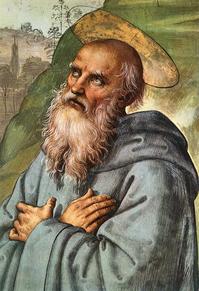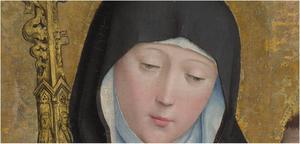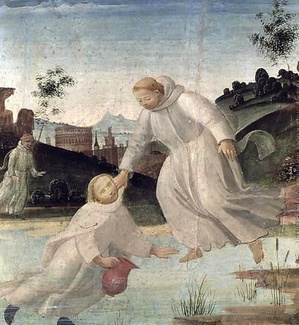Category: Benedictine saints & blesseds
Novena of Prayer to Saint Benedict, Day 4
Novena of Prayer to Saint Benedict, Day 3
The order of prayer
Novena of Prayer to Saint Benedict, Day 2
Novena of Prayer to Saint Benedict, Day 1
 Today begins nine days of prayer to Saint Benedict, ending at First Vespers of Saint Benedict’s Transitus (March 20). On March 21, many Benedictine monasteries around the world will observe the death of Benedict (+547) with solemnity, if you follow another liturgical calendar other than the Roman one, while other monasteries will celebrate July 11 as a feast, the translation of Benedict’s bones.
Today begins nine days of prayer to Saint Benedict, ending at First Vespers of Saint Benedict’s Transitus (March 20). On March 21, many Benedictine monasteries around the world will observe the death of Benedict (+547) with solemnity, if you follow another liturgical calendar other than the Roman one, while other monasteries will celebrate July 11 as a feast, the translation of Benedict’s bones.
Saint Frances of Rome
O God, Who in Saint Frances of Rome, has given us a model of holiness in married life and of monastic conversion, make us serve You perseveringly, so that in all circumstances we may set our gaze upon You and follow You.
This painting given here for today’s lectio is attributed to Antonio del Massaro da Viterbo, depicts Saint Frances of Rome (1384-1440) being clothed by the Mary in the white veil of her Benedictine movement that, even today, characterizes the Olivetan Benedictine Oblates of Mary she founded in 1425.
Mary, Mother of God wears a mantle of gold, which Saint Paul at the left wraps around Frances Romana. The presence of certain saints is instructive: the great evangelizer, Saint Paul, Saint Mary Magdalene (the Apostle to the Apostles and dressed in red) and Saint Benedict, the Father of Western Monastic Life, with the various ranks of angels, including Francesca’s Guardian Angel. Magdalene and Benedict wrap/invest the mantle on the gathered Oblates.
The angel below the Gothic windows is busy carding golden threads with a warp and loom. Nearby are two frisky dogs and two cats, a frequent sight in Rome. The Oblate Congregation, commonly thought to be woven together by heavenly graces and harassed by evil spirits. The evil one is given flesh in the form of cats and dogs. As a testimony of grace the Oblates flourish today at Tor de’Specchi. Several years ago I had the privilege with many others to pray in this monastery opened to the public only Saint Frances’ feast day.
I have longed hoped that the Oblates of Saint Frances of Rome would found a house in the USA. We are ready for this witness.
Saint Peter Damian
Saint Peter Damian is most known as the 11th century-Ravenna-born-monk and author. Peter was, in fact, a hermit. He was keen on the rights of the Church but also with the personal renewal and reform (i.e., conversion) as being an authentic witness to the gospel. The the primacy of discipleship with Christ as Lord and Savior was key. He was a Doctor of the Church.
In 2007, Pope Benedict dedicated a letter to the religious superior of the Monastery of San Gregorio al Celio, Father Guido Gargano on the 1000th anniversary of Saint Peter Damian’s birth. Read it here.
With Pope Benedict’s impending renouncing of the Peterine ministry, one can’t help but thinking that Saint Peter Damian is a personal model for Benedict’s forthcoming monastic retreat.
With the Church we pray,
Grant, we pray, almighty God, that we may so follow the teaching and example of the Bishop Saint Peter Damian, that, putting nothing before Christ and always ardent in the service of your Church, we may be led to the joys of eternal light.
Saint Scholastica
Deus, qui beátae Vírginis tuæ Scholásticæ ánimam ad ostendéndam innocéntiæ viam in colúmbæ spécie cælum penetráre fecísti: da nobis eius méritis et précibus ita innocénter vivere; ut ad ætérna mereámur gáudia perveníre.
O God, to show us where innocence leads, you made the soul of your virgin Saint Scholastica soar to heaven like a dove in flight. Grant through her merits and her prayers that we may so live in innocence as to attain to joys everlasting.
Let’s pray for all Benedictines, monks, nuns, sisters and oblates.
Saints Maurus and Placid
In the Benedictine tradition today is the feast of the young disciples of Saint Benedict, Maurus and Placid. The tradition holds that after the holy Benedict had established his twelve monasteries at Subiaco, noble Christians came from Rome, presenting their sons to be raised and educated among the monks. Not unusual given the state of Roman culture at that time. Among them were Maurus, an adolescent, the son of Euthicus, and Placid son of the patrician Tertullus. These young people become the first “oblates” in monastic life; they become models for all Benedictine Oblates today.
While the names of Maurus and Placid are not well known in “normal” Catholic circles except in Benedictine monasteries, we do recognize a few things today because of them. The oblation of the family to the Man of Blessing is where we get the idea of an Oblate in the Benedictine charism. You may have heard of the Blessing the Sick through the Intercession of Saint Maurus or even be familiar with the famous story of being saved from drowning.
The narrative of Placid being saved is given to us in the Dialogues of Saint Gregory the Great. There Gregory tells us Maurus and Placid went to fetch water in the lake. Placid falls into the water. Saint Benedict, aware of the situation due to God’s grace, sends Maurus to rescue the child Placid. Maurus, having received his abbot’s blessing, runs over the surface of the water, grabs Placid by the hair, pulls him out, and then runs back over the water to dry land, carrying the little one in his arms. Saint Benedict attributes the miracle to Mauris’ obedience; Maurus attributes it to Saint Benedict. But it was Placid who settles the debate: “When you pulled me out of the water, he says, I saw over my head Father Abbot’s hood, and I saw that it was he who pulled me from the water.” Listening to the Collect it seems that obedience wins: both Benedict and today’s saints are correct.
For us the story of Saints Maurus and Placid is very much connected with the notion of to whom do we belong; whom do we follow. That is, with whom do we share friendship (on the supernatural level)? God or creation? What we see in these two is the development in Benedict’s line of spiritual paternity of persevering in the seeking of God. One can only wonder what better eye witnesses there could be than Maurus and Placid in the mercy of God and the trust in Divine assistance in times of suffering. Perhaps this is why they are asked for intercession for the sick and why became patrons of Benedictine novices.
Saint Aelred of Rievaulx: God is friendship
O God, who gave the blessed Abbot Aelred the grace of being all things to all men, grant that, following his example, we may so spend ourselves in the service of one another, as to preserve the unity of the Spirit in the bond of peace.
Saint Aelred of Rievaulx (1110-1167) (1110-1167), consider to be the “Saint Bernard of the North,” was abbot of Rievaulx in England from 1146 until his death. The author of Spiritual Friendship, Saint Aelred’s Pastoral Prayer is a profound meditation on the Rule of Saint Benedict which shaped his thinking and led him (and his disciples) to prefer nothing to the love of Christ.
So, with today’s liturgical memorial of Saint Aelred celebrated especially by Benedictines and Cistercians, the Church’s memory of the life and teaching of Saint Aelred of Rievaulx, ought to open for us a renewed interest in friendship with Christ and with one another, as well as a more sincere devotion to the Cross. It is the Cross that shapes the life of the Christian and more poignantly, that of the person professing monastic vows as a monk, nun or the oblate promise. In his well-known treatise, Spiritual Friendship, Saint Aelred has a well-known and bold teaching: “God is friendship.” This is clearly an understanding of Saint John’s theology, “God is love.” In any case, God is friendship is Saint Aelred’s personal experience of God’s intimacy with him.
If God is “friendship,” then implications are unbelievably beautiful. I will leave you to tease out the application to your life.









